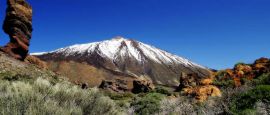The former capital and now a UNESCO World Heritage Site, La Laguna's layout was the blueprint for many Latin American cities, including Cuba. Its old quarter has fine architecture from the 16th, 17th and 18th centuries and its Cathedral has been refurbished. Excellent daily market on Plaza Cristo and some mighty fine eateries.
Tenerife things to see and do
Tourist offices
Address: 64 North Row, London, W1K 7DE, United Kingdom
Tel: +44 207 317 2011.
www.spain.info
Address: Avenida Constitución, 12, Santa Cruz de Tenerife, Tenerife, 38005, Spain
Tel: +34 902 321 331.
www.webtenerife.com
Address: 666 Fifth Avenue, 35th Floor, New York City, NY 10103, United States
Opening Hours: This office is not open to the public; enquiries through the website only.
www.spain.info
Once Tenerife’s wealthiest town, Garachico's fortunes were swept away by a volcanic eruption in 1706, which destroyed the harbour and buried many of its fine buildings. Today the town's rock pools, hewn from solidified lava, are popular with locals and visitors alike, and are a brilliant place to swim amongst the tropical fish.
Visitors can (very nearly) reach the summit of Spain’s highest peak by cable car, which runs up the side of this vast volcano (get there early to avoid queues). Take the path west to Pico Viejo for satellite views over the old crater and to see La Gomera, El Hierro and La Palma shimmering on the horizon.
Siam Park is one of Europe's biggest water parks. This Thai-inspired aquatic complex has some of the highest, fastest and longest water rides in the world including a wave machine that supplies surf-sized waves alongside a white sand beach. There’s also the appropriately named Tower of Power, a vertical water slide that plunges 28m (92ft) into a pool below.
Teide National Park has a plethora of walking trails, the toughest and most rewarding being the hike up all 3,718m (12,198ft) of Mount Teide to watch the sunrise. A night in the Altavista mountain refuge avoids the need for bureaucratic permissions and presents the opportunity for stargazing.
Formed by lava flows from the nearby Pico Viejo volcano, Cueva del Viento is a 17km (10 mile) labyrinth of underground tunnels. Located at Icod de los Vinos, the subterranean network is home to fascinating lava formations and 48 species of troglobites including blind cockroaches. Daily tours are available and reservations essential.
In the warm Atlantic water between Tenerife and La Gomera, pods of bottle-nosed dolphins and pilot whales gorge on a constant tide of unsuspecting fish making this one of the best places on the planet to see these cetaceans in their natural habitat. Boats go out three times daily from the harbour at Los Gigantes.
The village of Masca is perched on a rocky outcrop and flanked by towering massifs on the edge of the Teno Mountains. Inaccessible until the 1970s, Masca is the starting point for a challenging, three-hour trek down the Masca Ravine to the sea, where boats take weary hikers to Los Gigantes. Make sure you pick up tickets for the boat in the village before you set off.
Well off the tourist trail, charming Candelaria is the spiritual capital of Tenerife. Its landmark basilica is certainly worthy of a visit and is most notable for its murals and statue of Black Madonna. The Plaza de la Patrona is another must see, with its grand bronze statues that represent the nine kings that ruled Tenerife prior to Spanish conquest. Tapas bars and great bakeries add to the town’s appeal.
Guimar is home to Tenerife's most enigmatic and enduring mystery; ancient pyramids. Some theorists believe the Pyramids of Guimar are proof that the Egyptians could make long sea voyages and may have discovered America. Most historians dispute this theory. Whatever you believe, the pyramids make for a compelling day trip.
A magnet for surfers, windsurfers and kitesurfers, El Medano has the best natural beaches on the island, several of them favoured by naturists. The resort's laid back, bohemian culture and its great cafes make it an attractive alternative to the busier southwest coast resorts.
Tenerife's original resort, Puerto de la Cruz still retains its Canarian culture and roots. Photogenic plazas surrounded by bars and restaurants; a fishermen's quarter which has morphed into the town's restaurant district; and a pretty harbour hosting year-round cultural events make it worthy of a visit.
The warm, clear Atlantic waters off Las Galletas conceal a submerged wonderland of volcanic arches, tunnels and caves teeming with tropical marine life and offer some of the best diving in Europe. Other excellent dive locations include Los Gigantes and Puerto de la Cruz, where you can explore the wreck of a DC3 plane crash.
Tenerife's most aristocratic town, sited in the lush valley from which it takes its name, La Orotava has a picturesque old quarter where you can see some of the best examples of traditional balconied mansions. Pavement cafes, tapas bars, gardens and antique shops add to its colonial attractions.
Capital of the western Canary Islands, the city of Santa Cruz is a great city break destination. Impressive architecture, leafy plazas bustling with cafes, art galleries and museums are all in easy strolling distance. City highlights are Parque Garcia Sanabria, Museum of Man & Nature, Plaza España and TEA art gallery. Evening entertainment centres around the trendy bars and restaurants of the Noria District.
The ancient peaks of the Anaga Mountains are perfect for a spot of hill walking. Carved by plunging ravines, peppered with white-walled hamlets and coated in lichen-dripping laurisilva forests, life in the Anagas has changed little in centuries. Challenging and dramatic, the mountains test and reward hikers in equal measure.
Do you have any Feedback about this page?
© 2025 Columbus Travel Media Ltd. All rights reserved. No part of this site may be reproduced without our written permission, click here for information on Columbus Content Solutions.








 You know where
You know where